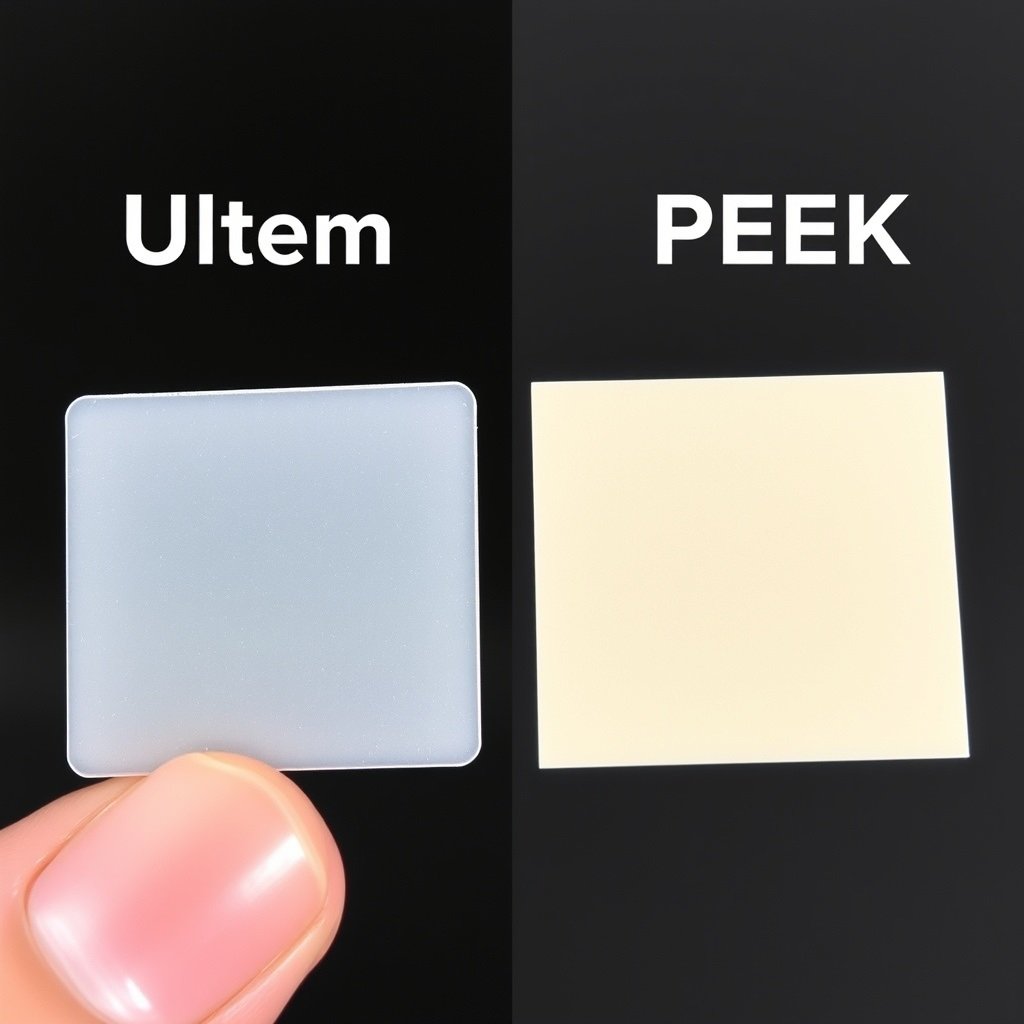


This paper makes a detailed comparison between Ultem (PEI) and PEEK, two high performance plastics that are reputed as having very outstanding properties. We are going to compare the term Ultem and PEEK following the mechanical properties, thermal resistance, chemical resistance, and adaptability to other industrial applications. This comparison will be of great relevance to the engineers or designers who are in a position of deciding between Ultem and PEEK.
Ultem, also known as Polyetherimide (PEI), and PEEK, short for Polyether Ether Ketone, are both high-performance plastics prized for their superior properties. The comparison showcases PEEK’s remarkable mechanical strength and high-temperature resistance. Similarly, Ultem offers a unique combination of properties, making Ultem and PEEK suitable for demanding applications. Ultem resin is available in different grades.
High-performance plastics like PEEK and Ultem are critical in industries requiring materials that can withstand extreme conditions. Their exceptional mechanical properties, high-temperature resistance, and chemical resistance make PEEK and Ultem essential. These materials are crucial for ensuring reliability and safety in demanding applications, such as aerospace and medical devices, making PEEK excel in extreme environments.
Ultem and PEEK find extensive use across diverse sectors. The following table summarizes some common applications for each material:
| Material | Applications |
|---|---|
| Ultem | Aerospace components, automotive parts, and medical instruments |
| PEEK | Seals, bearings, and electrical connectors (especially where high-temperature resistance and chemical inertness are required) |
The comparison highlights their tailored suitability for specific industrial needs and requirements.
When comparing PEEK, PEEK surpasses Ultem in tensile strength and overall mechanical strength. PEEK has a higher tensile strength, enabling it to withstand greater loads without deforming. Ultem, however, still provides adequate strength for numerous applications. This difference can be critical when choosing between Ultem and PEEK.
Both Ultem and PEEK are known for their high-temperature resistance, but PEEK excels in this area. The high glass transition temperature of PEEK allows it to maintain its properties at higher temperatures compared to Ultem. This makes PEEK and Ultem ideal for applications where exposure to elevated temperatures is expected. PEEK is also well-suited to prevent deformation at high temperatures.
Flexural modulus, a measure of a material’s stiffness, is another important mechanical property to consider. PEEK generally exhibits a higher flexural modulus compared to Ultem. This means that PEEK is stiffer and more resistant to bending under load compared to Ultem 9085. The comparison shows PEEK is often preferred in applications where rigidity is paramount.
The differences between Ultem and PEEK extend beyond mechanical strength, encompassing aspects like chemical resistance and processing characteristics. PEEK vs Ultem, PEEK often exhibits superior resistance to a broader range of chemicals compared to Ultem. When choosing between Ultem and PEEK, PEEK’s processing may require higher temperatures, affecting manufacturing costs.
Despite their differences, Ultem and PEEK share several key similarities that make them both high-performance plastics. Ultem and PEEK offer excellent high-temperature resistance, although PEEK excels at even higher temperatures. Both materials also provide good dimensional stability and mechanical properties, making them suitable for demanding applications. This makes PEEK very useful.
When comparing PEEK vs Ultem, cost is a significant consideration. PEEK is generally more expensive than Ultem. This cost difference can influence the decision when choosing between Ultem and PEEK, especially for large-scale applications. While PEEK offers superior properties, the cost-effectiveness of Ultem makes it a viable option.
PEEK boasts unique properties that set it apart as a high-performance plastic. High-temperature resistance allows PEEK to maintain its properties in extreme conditions. PEEK has a higher tensile strength and stiffness. PEEK is also biocompatible, making it ideal for medical applications. PEEK excels where other materials fail. The comparison is very strong.
The unique properties of PEEK enable its use in diverse industries. It is often used for implants and surgical instruments in the medical field. Choosing between Ultem and PEEK depends on the demands of the environment and the application. Some key applications are summarized below:
| Industry | Key Properties Leading to Use |
|---|---|
| Aerospace | High-temperature resistance and chemical inertness |
| Automotive | High-temperature resistance and chemical inertness |
The advantages of using PEEK stem from its exceptional properties. PEEK’s high-temperature resistance ensures reliability in demanding thermal environments, while its chemical resistance guarantees longevity. PEEK is also known for its wear resistance and dimensional stability. This makes PEEK a reliable choice. Compared to Ultem, PEEK can be applied in a broader range of applications.
Ultem offers a distinctive combination of properties that make it a standout high-performance plastic. Ultem distinguishes itself with a high glass transition temperature and inherent flame retardancy without needing additives. This unique combination of mechanical properties and chemical resistance makes it desirable for a range of applications.
Ultem’s versatility is evident across various sectors due to its unique properties. Some applications are detailed below:
| Sector | Application & Properties |
|---|---|
| Aircraft | Interior components due to flame retardancy and low smoke emission. |
| Automotive & Medical | Automotive: Under-the-hood components. Medical: Medical devices due to sterilizability and biocompatibility. |
Choosing between Ultem and PEEK, it is important to consider benefits of Ultem which include a balance of properties and cost-effectiveness. Ultem offers good mechanical strength and dimensional stability at a lower price point, making it attractive for applications where ultimate performance is not required. Ultem offers ease of processing, which reduces manufacturing costs.
When considering 3D printing with PEEK and Ultem, the filament characteristics are critical. Ultem 9085 and PEEK filaments exhibit high-temperature resistance, making them suitable for creating parts that will endure demanding conditions. Ultem offers easier processing in 3D printing compared to PEEK, as PEEK requires higher processing temperatures.
3D printing with Ultem vs PEEK presents unique challenges due to their high-temperature requirements. PEEK needs a heated build chamber to prevent warping and ensure good layer adhesion. Ultem offers a slightly easier printing process, but careful temperature control is still essential for both.
Possibilities are new with high-performance plastics. PEEK is outstanding in the strength and chemical resistance of the manufactured parts whereas Ultem is a compromise between property and printability. Such materials are used to make prototypes, custom-made tooling, and final components used in the aerospace, medical and automotive industries. They have an option of using Ultem or PEEK.
In conclusion, the comparison of Ultem and PEEK matters when it comes to making decisions on what material satisfy particular demands. PEEK is more resistant to high temperatures and chemicals than Ultem, and thus, is better in extreme conditions. Both Ultem and PEEK are fit since they possess high-performance, good mechanical properties, and dimensional stability, thus being applicable in demanding applications.
Ultem and PEEK have different applications where one material works more efficiently compared to the other. PEEK is selected over other polymers because it is suitable in applications that require an extreme high temperature resistance and inertness to chemicals. But in cases where high-performance is required at a lower price rate, Ultem provides optimal combination of properties and should be recommended.
It is likely that high-performance plastics such as Ultem and PEEK will be used in future printing more as the industry grows. They are in research and development to make them better processable and cheaper bringing in their usage in more industries. PEEK is resistant to a higher temperature.
